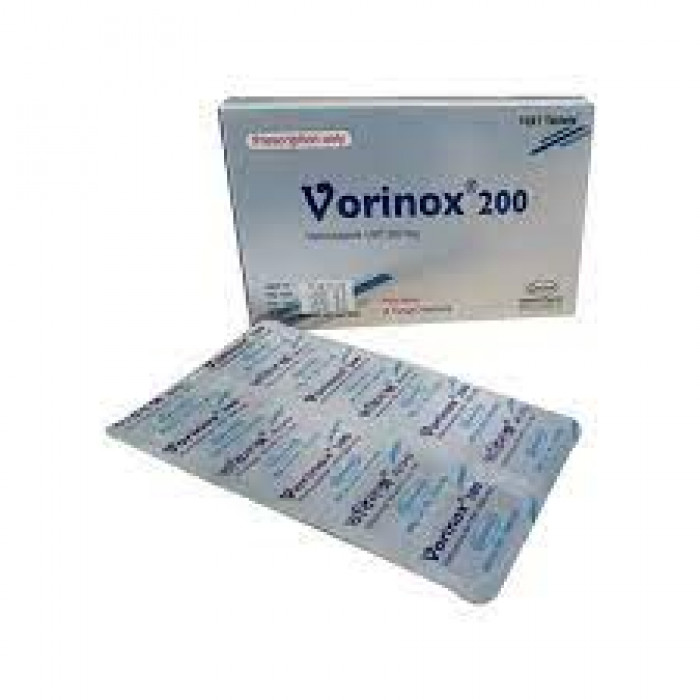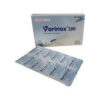Description:
Indications
An azole antifungal drug is called voriconazole. For the treatment of the following fungi infections in people 12 years of age and older:
- Aspergillosis is widespread
- candidiasis and non-tuberculous candidemia in the skin, abdomen, kidneys, bladder wall, and wounds
- One type of candidiasis that affects the esophagus is called candida esophagitis.
- Serious infections are caused by Scedosporium apiospermum and Fusarium species, particularly Fusarium solani.
- Patients who are unwilling or unable to tolerate alternative therapies.
Pharmacology
A triazole antifungal medication called voriconazole is used to treat severe fungi infections. Voriconazole binds to and prevents the production of ergosterol by inhibiting the CYP450-dependent 14-alpha sterol demethylase. Ergosterol in the fungal cell membrane is depleted when 14-alpha sterol demethylase is inhibited.
Dosage & Administration
Oral-
- Take the voriconazole tablet or powder for suspension at least an hour before or after a meal.
- For individuals who weigh 40 kg or more, the recommended loading dose is 400 mg or 10 ml every 12 hours for the first 24 hours, followed by 200 mg or 5 ml twice daily for the remainder of the first 24 hours.
- Body weight under 40 kg: For the first 24 hours, a loading dose regimen of 200 mg or 5 ml every 12 hours is followed by a maintenance dose regimen of 100 mg or 2.5 ml twice daily. or as instructed by the licensed doctor.
Injection-
Invasive Aspergillosisd :
- 6 mg/kg every 12 hours for the first 24 hours is the loading dose.
- Maintenance 4 mg/kg 12 hours per dose.
Deep tissue Candida infections and candidemia in nonneutropenic patients:
- 6 mg/kg every 12 hours for the first 24 hours is the loading dose.
- Maintenance 3?4 mg/kg, given every 12 hours.
Fusariosis and sedosporiosis:
- 6 mg/kg every 12 hours for the first 24 hours is the loading dose.
- Maintenance 4 mg/kg 12 hours per dose.
Interaction
- Inhibitors and inducers of CYP3A4, CYP2C9, and CYP2C19: Vary the dosage of Voriconazole as necessary and watch for any negative effects or diminished effectiveness.
- Voriconazole may increase the concentration and activity of drugs that are substrates of CYP3A4, CYP2C9, and CYP2C19. Reduce the dosages of these other medications and monitor any negative effects.
- Increase the maintenance dosage of Voriconazole when Phenytoin or Efavirenz are also administered.
Contraindications
Hypersensitivity to Voriconazole or any of the drug’s other ingredients-
Because of the potential for major adverse effects when combined with terfenadine, astemizole, cisapride, pimozide, or quinidine, sirolimus is not recommended.
Due to the possibility of efficacy loss, rifampin, carbamazepine, long-acting barbiturates, efavirenz, ritonavir, rifabutin, ergot alkaloids, and St. John’s Wort should not be taken together.
Side Effects
Abdominal pain, anemia, blurred vision, headache, chest pain, nausea, and diarrhea are the most prevalent side effects.
Pregnancy & Lactation
In pregnant women, there are no sufficient and well-controlled trials. Only if the possible benefit outweighs the risk to the fetus should it be taken during pregnancy.
Precautions & Warnings
Long-term exposure (treatment or prophylaxis) of more than 180 days necessitates careful consideration of the benefit-risk ratio. Long-term voriconazole medication has been linked to squamous cell carcinoma of the skin (SCC).
Storage Conditions
Keep out of children’s reach. Store in a cool, dry area below 25?C and out of direct sunlight. Voriconazole powder for suspension should be stored at a temperature of 2? to 8?C.







Reviews
There are no reviews yet.